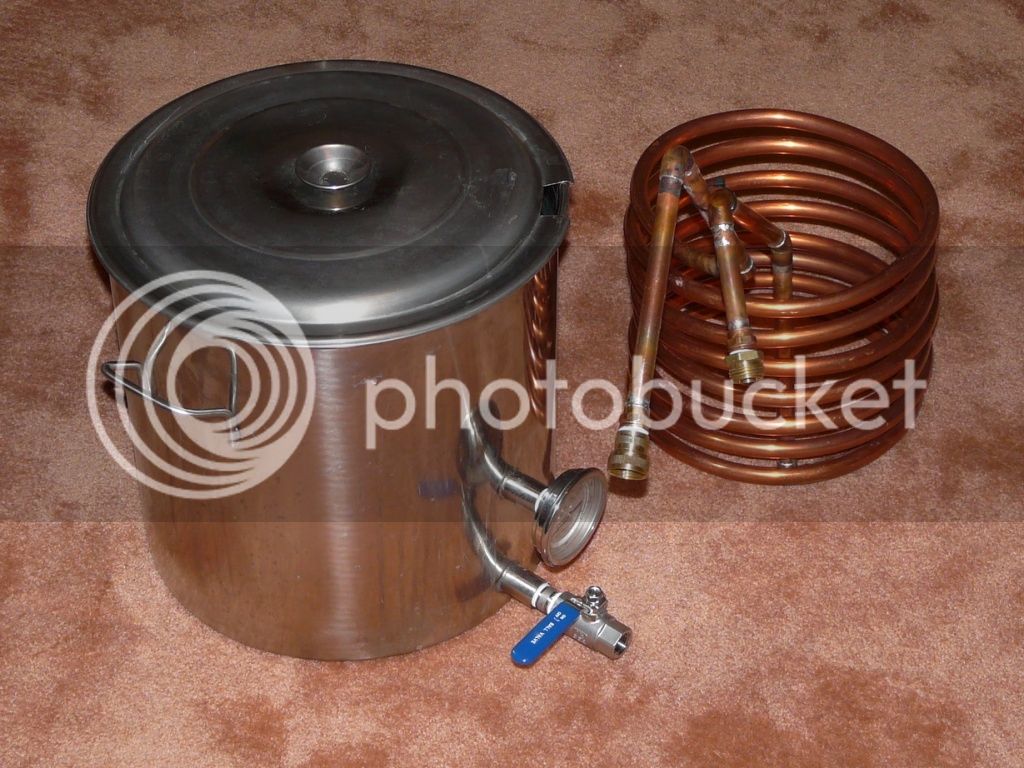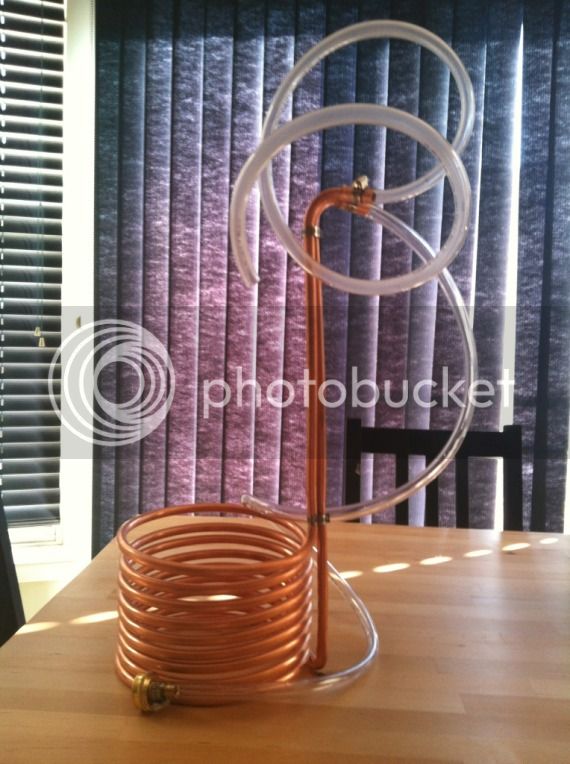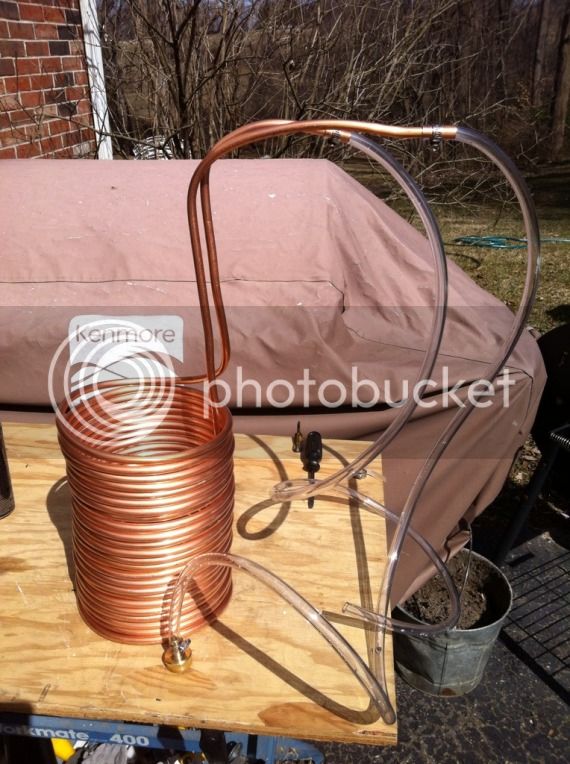So I'm getting back into home brewing (all grain this time around) and wanted to pick up a wort chiller but almost half of all the reviews Ive read of immersion chillers saying that the fittings leak (like for hooking it up to a garden hose). Is there a reliable chiller out there youve heard of that doesnt require a trip to the hardware store for replacement parts or, worse, a need for replacement by the vendor? I hate the thought of just ordering one and hoping that I am one of the lucky ones who's chiller works correctly right out of the box. Id be willing to spend the extra $$$ to guarantee a leak-free immersion chiller but do they not exist? Im surprised that so many distributors fail to address this quality issue. Thanks for any input. I'm ready to get brewin' but need all of the equipment first! Also, not ready yet to delve into the plate chillers.
You are using an out of date browser. It may not display this or other websites correctly.
You should upgrade or use an alternative browser.
You should upgrade or use an alternative browser.
Competent Wort Chiller
- Thread starter KDBrew
- Start date

Help Support Homebrew Talk - Beer, Wine, Mead, & Cider Brewing Discussion Forum:
This site may earn a commission from merchant affiliate
links, including eBay, Amazon, and others.
I've had good luck with one that I just got off ebay. Seems that they are basically all the same, not much difference between them based on my research. My connection points leaked (where the vinyl tubes connect to the copper) the first time I used it but I've since learned that you can't just turn the water on full blast and now at a reduced pressure the setup works perfectly.
petey_c
Senior Member
I got mine from a hardware/homebrew store (Karps). No leaks for well over a year, then I had to tighten the hose clamps a little. I would say take for a test run prior to using it for the first time. Bring the pressure up a little slowly at first. You don't want a loose hose shooting water all over the house.
ratbastrd05
Active Member
- Joined
- Feb 17, 2013
- Messages
- 41
- Reaction score
- 8
Mine has leaked at the connections, but simply takes a quick tightening with a screwdriver to stop. From LHBS. Leaked outside of kettle, so not a big deal in my experience.
I am quite happy with the one I purchased from Midwest. It is a stainless steel model and has yet to leak at all. I put a new rubber gasket in it when it came. My record so far is to take from boiling to 80F in 90 seconds with stirring. Last batch was 5 mins, but my ground water temp was a bit warmer. I may buy another and make a ice bath to pre-cool for summer brewing.
I had the same concerns you do when I was shopping for a chiller, so I made my own that addressed those issues.

My garden hose fittings that have been leak-proof. You can change out the little hose gaskets as needed if they ever start to drip.
I angled the inlet and outlet pipes downward just in case they ever develop a drip. I don't want it getting in the wort.
One thing I noticed about the type that uses vinyl tubing is that it doesn't stand up well to the heat and tends to kink at the fitting, reducing flow. You can replace it with silicone tubing to fix that.

My garden hose fittings that have been leak-proof. You can change out the little hose gaskets as needed if they ever start to drip.
I angled the inlet and outlet pipes downward just in case they ever develop a drip. I don't want it getting in the wort.
One thing I noticed about the type that uses vinyl tubing is that it doesn't stand up well to the heat and tends to kink at the fitting, reducing flow. You can replace it with silicone tubing to fix that.
HeadyKilowatt
Well-Known Member
Build your own for about 1/2 the price of buying one. Make a coil (lots of info out there on the details of the how-to), slip silicone tubing right over the inlet and outlet ends, and secure with a couple of hose clamps. Barbed garden hose fitting on the other end of the inlet tube to hook it up to a faucet/hose. If it ever leaks, just tighten the hose clamps. And bend the inlet/outlet ends of the coil downward so that any leaks that might develop drip outside of the kettle.
tgmartin000
Well-Known Member
I picked up a 1/2" fridge coil, 50' long for $75 bucks at home depot, plus 10 bucks for fittings and tube. It leaks at the hose connection, but so what? It doesn't leak into the beer. It doesn't look the greatest, but it works like a mofo.
Using that sucker plus my old 25' 3/8" as a prechiller, I got 5.5 gal of wort to 46 degrees in about 15 min.
Using that sucker plus my old 25' 3/8" as a prechiller, I got 5.5 gal of wort to 46 degrees in about 15 min.
im not big on plate chillers either but have u considered a counterflow chiller instead of immersion? I picked an awesome 25' one up on Amazon and it works on gravity feed and is awesome, only needed two extra hose clamps and s small piece of silicon tubing to run it from my BK to the intake of the CFW... the clamps and tubing on the out port is what I would have normally used from the BK to the carboy anyway.
haven't had a problem yet, making it IMO a well spent 85 bucks.
haven't had a problem yet, making it IMO a well spent 85 bucks.
IamCanadian
Member
- Joined
- Mar 31, 2013
- Messages
- 16
- Reaction score
- 1
For what you are going to pay in parts to even make your own immersion chiller I'd consider getting one of these...
http://www.dudadiesel.com/choose_item.php?id=HX1230BWGH
I bought this model and it works fantastic and it comes with all the fittings you'll need. Below is a video of it in action...
http://www.dudadiesel.com/choose_item.php?id=HX1230BWGH
I bought this model and it works fantastic and it comes with all the fittings you'll need. Below is a video of it in action...
Last edited by a moderator:
USMCBrewer
Well-Known Member
- Joined
- Feb 13, 2013
- Messages
- 76
- Reaction score
- 6
I built this for about $50. It's 25' 1/2" flexible copper pipe. I wanted the full 25' coiled up so I picked up some fittings to connect some 1/2" rigid copper pipe I had laying around for the vertical lengths. Put some 90* fittings and then some threaded fitting to allow me to thread 3/8" hose fittings. I can't use a garden hose or any other type of hose from my kitchen sink so I bought a fountain pump from Home Depot. I fill a cooler with tap water and ice an pump it through the cooler. I can cool my wort from boiling to 70* in about 15 min. It's all soldered together and haven't had any problems with leaks. Works great.


DrinkingLounge
Well-Known Member
I have a stainless one from midwest I think on sale during xmas, and I've just used it once so far, but I didn't have any issues with it and it was so much better than cooling with ice in a tub like I did my first time.
I was borrowing a friends when he needed it back.... a 20ft homemade copper. I just purchased these two, 1 for the 5gal batches and one for the 10gal 43.99 and 66.99 and only 16.14 to ship to CA finally 2 batches 15g at once no waiting!!!!
http://www.nybrewsupply.com/beer-ho...rs/3-8-x-25-stainless-steel-wort-chiller.html
and
http://www.nybrewsupply.com/stainless-steel-wort-chiller-38-x-50.html


http://www.nybrewsupply.com/beer-ho...rs/3-8-x-25-stainless-steel-wort-chiller.html
and
http://www.nybrewsupply.com/stainless-steel-wort-chiller-38-x-50.html


AVLbrewing
Well-Known Member
- Joined
- Jan 16, 2013
- Messages
- 173
- Reaction score
- 19
I went the DIY method with my chiller and haven't had any leaks. I just used the proper sized tubing and tightened the hose clamps pretty tight. The garden hose connector is also a good distance away from the kettle with the ends angled down. In the event of a leak either from the hose clamps or the garden hose adapter it won't make a mess in my wort. So far so good! It only cost me $34 in supplies and was one of the most stress free DIY projects I've done. Since I snapped the picture below I changed the output tubing to 10' and run it further away from the kettle. This is nice since when I'm outside I have more flexibility where I put my kettle.


freisste
Well-Known Member
The issue I have seen on immersion chillers is when people cheap out and attach the tubing to their flexible copper directly. I'm not saying it can't be done, but it is really easy to under tighten and get leaks. Almost as easy as it is to over tighten and get leaks from bending the flexible copper.
My suggestion, if you are worried and want to go the DIY route, is to get compression fittings and hose barbs to attach your vinyl to your copper. Then use a little Teflon tape on the threads and you are good to go.
My suggestion, if you are worried and want to go the DIY route, is to get compression fittings and hose barbs to attach your vinyl to your copper. Then use a little Teflon tape on the threads and you are good to go.
broadbill
Well-Known Member
And bend the inlet/outlet ends of the coil downward so that any leaks that might develop drip outside of the kettle.
This is the critical part....you can kill yourself coming up with a leak-free design or design it so the leak doesn't matter in the first place. Perfect is the enemy of good.
DerrangedPOJO
Well-Known Member
i got 1/2" by 25' on amazom for 23 bucks and free shipping. Total i have 30 in it. i pretty much made it like Big Floyds. Does not leak! and i spent half as much what the LHBS wanted or ebay.
For what you are going to pay in parts to even make your own immersion chiller I'd consider getting one of these...
http://www.dudadiesel.com/choose_item.php?id=HX1230BWGH
I bought this model and it works fantastic and it comes with all the fittings you'll need.
Thanks for the link on that. I'm considering adding a plate chiller when I make the jump into building a recirculating E-BIAB setup. That one may be a good economical option.
IamCanadian
Member
- Joined
- Mar 31, 2013
- Messages
- 16
- Reaction score
- 1
Thanks for the link on that. I'm considering adding a plate chiller when I make the jump into building a recirculating E-BIAB setup. That one may be a good economical option.
I don't use any sort of pump with that chiller plate, just gravity. Takes about 5-8 min. to cool a 5 gallon boil to pitching temps.
I don't use any sort of pump with that chiller plate, just gravity. Takes about 5-8 min. to cool a 5 gallon boil to pitching temps.
That's pretty impressive. What is your normal pitch temp?
Thanks all for the healthy discussion. I've found that hearing many other's opinions helps me decide the best course of action. So when using a plate chiller is it hard to regulate the temp? I'd hate to transfer the whole wort to the fermentor and it still be too hot to pitch. Then what do you do? I'd be nervous to use a plate chiller without an inline thermometer to know what the temp was as it transfers to the ferm bucket.
So when using a plate chiller is it hard to regulate the temp? I'd hate to transfer the whole wort to the fermentor and it still be too hot to pitch. Then what do you do? I'd be nervous to use a plate chiller without an inline thermometer to know what the temp was as it transfers to the ferm bucket.
I believe that you regulate the effect of the plate chiller on the wort temp mostly by increasing/decreasing the flow of the wort through the chiller.
If you are doing a single pass gravity feed and it's not getting cool enough, you can always stop before the bucket gets too heavy, dump that wort back into the kettle and begin again.
IamCanadian
Member
- Joined
- Mar 31, 2013
- Messages
- 16
- Reaction score
- 1
That's pretty impressive. What is your normal pitch temp?
24C was achieved for 5 gallons.
An inline thermometer is a good idea but not required. I just did a test batch running boiling hot water through the plate chiller 1st and adjusted the ball valve coming out the kettle into the chiller plate to see where i needed to be. I knew before hand that 1/2 open would chill it down plenty.
24C was achieved for 5 gallons.
Hmmmmm. That's 75.2*F.
If I do end up incorporating a plate chiller into my brewing, I'll probably set it up where I can recirculate the chill water out of a cooler into which I can add ice. I like to get my wort (for ales) down to below 18*C (64.5*F) and lagers considerably cooler before pitching.
If it's a part of an E-BIAB system (hopefully before this summer), recirculating the wort though the plate chiller and back into the kettle until cool enough would be pretty straightforward.
I believe that you regulate the effect of the plate chiller on the wort temp mostly by increasing/decreasing the flow of the wort through the chiller.
If you are doing a single pass gravity feed and it's not getting cool enough, you can always stop before the bucket gets too heavy, dump that wort back into the kettle and begin again.
Makes sense. Hadn't thought about pouring it back in (which would make me nervous) but I think I'm just over thinking the whole exact temp thing. As a new brewer it just seemed like an IC would give you the best control over the temp as you could dial it in and then when you hit your desired temp you could transfer. Guess the trade off is the speed at which plate chillers get the temp down.
IamCanadian
Member
- Joined
- Mar 31, 2013
- Messages
- 16
- Reaction score
- 1
I was dead set on getting a plate chiller until I heard of problems with sanitizing them. Not knowing if something residual is trapped inside worry a me.
I was worried too. You need to make sure of have some sort of hop filter in place so you are not running junk through it. So far so good and it seems to clean very easy by flushing water through in both directions. To sanitize prior to chilling you just need to run the hot wort through it for few seconds before you crank on the cold water for chilling.
I remember reading a thread on hear asking of how to get something out and some said to bake. Others were debating over some caustic compound. At that point I opted for an immersion. Not trying to scare anyone off the plate chiller buy, but just putting out food for thought on what I have read on here before.
petey_c
Senior Member
I'll sort of second what rkhorn said, but I'm economical in my brew efforts (lazy). 20 minutes before the end of the boil, immerse the immersion chiller to sanitize it. Put the pot in the sink and run tap water through the chiller for about 13 minutes to chill to about 70°F. Pour the cooled wort into the primary. Disconnect the IC and bring it to the shower to rinse off any hops/wort residue. I think an plate chiller would have me worrying if I got all the schist out of it.
kombat
Well-Known Member
I am quite happy with the one I purchased from Midwest. It is a stainless steel model and has yet to leak at all. [...] I may buy another and make a ice bath to pre-cool for summer brewing.
If you're going to buy a new chiller anyway, upgrade to a plate chiller, and use your existing IC as you described, as a "pre-chiller" in an ice bath. You'll get from boiling down to lager temperatures in literally seconds.
This is the critical part....you can kill yourself coming up with a leak-free design or design it so the leak doesn't matter in the first place. Perfect is the enemy of good.
Made this guy a few weeks ago. Kept the inflow end a bit longer so that it would be well outside of the kettle. Outflow is not as lengthy but shouldn't be as risky.

kombat said:If you're going to buy a new chiller anyway, upgrade to a plate chiller, and use your existing IC as you described, as a "pre-chiller" in an ice bath. You'll get from boiling down to lager temperatures in literally seconds.
That's a great idea, but I'm still worried about gunk left in the plate chiller.
Similar threads
- Replies
- 2
- Views
- 795
- Replies
- 4
- Views
- 534

